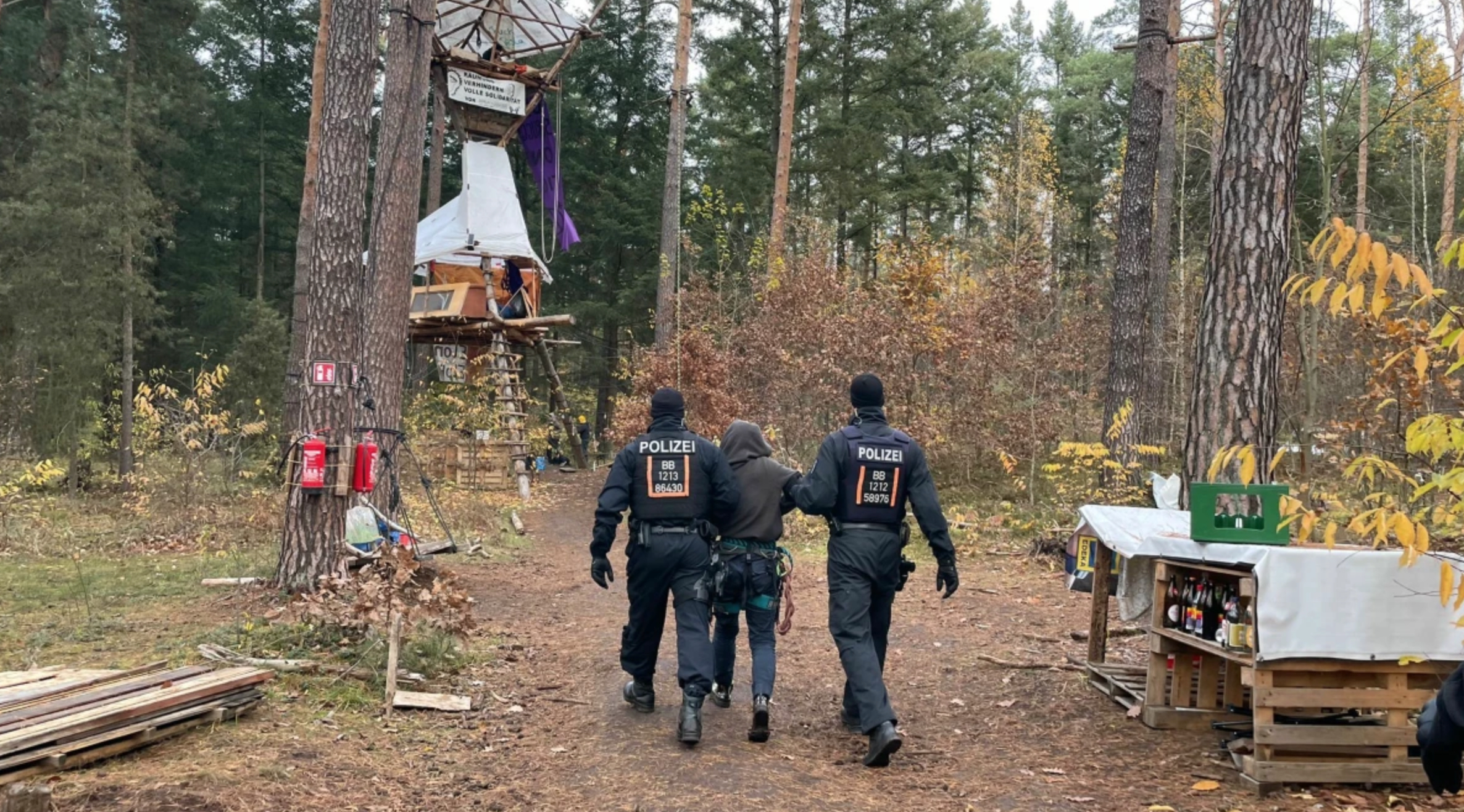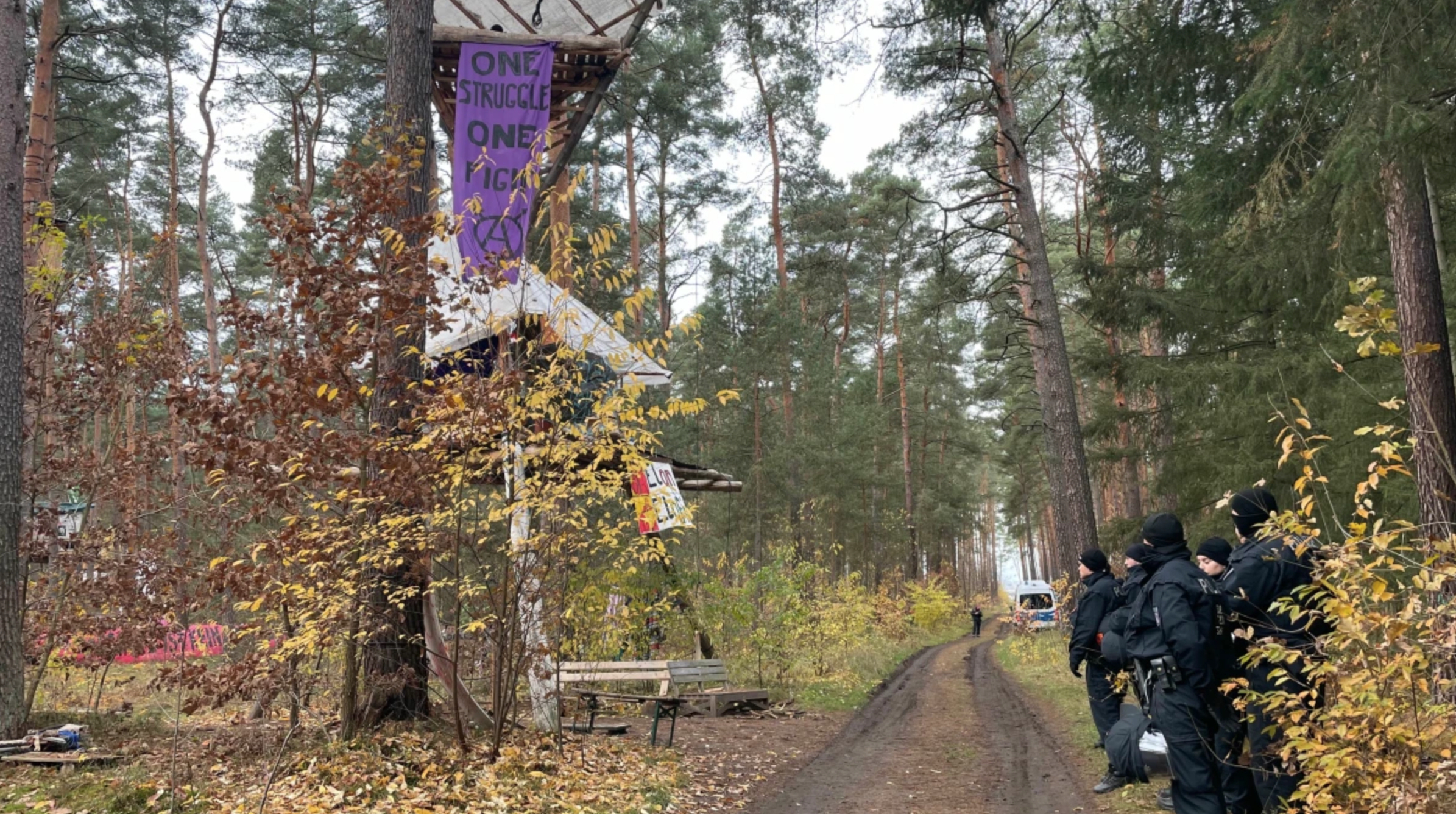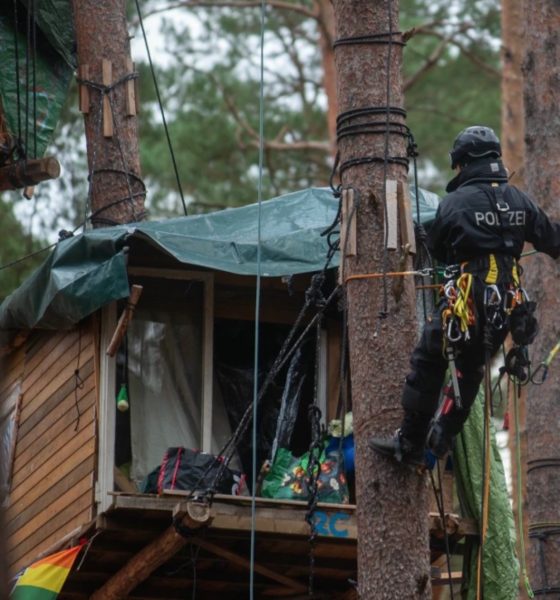Since February, Tesla has been dealing with protestors in the nearby forest it hopes to cut down for expansion plans. Many of the environmental activists still remain, and this week, local police have launched an operation to try to remove them.
Protestors have been staying in treehouses in a local forest near Tesla’s Grünheide Gigafactory in efforts to stop the company from removing trees in preparation for its upcoming expansion. On Monday, however, German publication Moz.de reported that a large team of police has been deployed to the site to remove the activists, after some of them refused to leave even when World War II bomb relics had been discovered on site.
The outlet says that a large number of police vehicles arrived at the forested area near the station’s fishing lock on L38, expected to be a longer-term deployment than usual for the authorities given the protestors’ refusal to leave. Grünheide press contact Beate Kardels has also said that the activists had so far been uncooperative and would likely continue to resist leaving, despite ongoing searches for World War II ammunition in the area.
“We stay here,” said a spokeswoman for the activists. “We will not allow the billionaire Elon Musk to destroy nature for its profit interests.”
Police have thus far resisted a flat-out eviction of the group, which is dubbed Tesla-den-Hahn-abdrh translating to Tesla-turn-off-the-faucet. The group has managed to rely on its right to assembly as a legal backing for its ability to stay in the forest.
Still, police have been removing protestors from the trees while the group shouts “revolution,” though many activists have attempted to scale the trees to avoid seizure.
Credit: Moz.de Credit: Moz.de Credit: Moz.de


Tesla Giga Berlin expansion progresses with 3K trees cut
“Come to Grünheide and show your protest with us,” says the group’s spokeswoman Karolina Drzewo. “This morning, freedom of assembly is being trampled under the pretext of a movement of struggle and the will of Elon Musk and Co. is being punched through.”
Although authorities have destroyed some of the barriers and treehouses created by the group, a spokesman for the police department has said that its goal on Monday was not to completely clear the camp, but rather to clear a roughly 5,000 square metre space in the camp where it seeks to continue searching for old ammunition.
Activists have said that police are also actively separating the rope connections to the tree houses, and they’ve been using loudspeakers to repeatedly ask them to leave the area. While the police have attempted to maintain a peaceful approach, they also say that they may be forced to dissolve the assembly through coercion if necessary, and they’ve managed to remove a few of the activists from the area.
Police are currently guarding the outskirts of the treehouse camp, though those in the group argue that the ammunition doesn’t pose a threat to the forest since it’s been embedded in the ground for several decades.
“We have opposed the profit interests of a billionaire here and we were and is aware that the police will implement their interests because they want to get us out of here,” 23-year-old activist Mara told Moz.de. “The police want us to volunteer to vacate parts of our protest camp for a bombing. But we will not give up the protest camp.”
Tesla was officially approved for the first stage of its expansion plans last month, which requires the company to remove several trees from the forest, as it has already begun doing so. The company has also shared plans to plant three times as many trees as it cuts down for the expansion, and it had already planted one million trees so far this year as of July.
As of September, Tesla had successfully cut down around 3,000 trees in preparation for the expansion, specifically to create a 1.86-mile construction road to the upcoming facility. The road will be located between L23 and the nearby motorway, and it’s expected to make it easier to transport construction materials to and from the site.
What are your thoughts? Let me know at zach@teslarati.com, find me on X at @zacharyvisconti, or send us tips at tips@teslarati.com.
Tesla gives Giga Berlin workers new, higher wages without union involvement

Elon Musk
Elon Musk and Tesla AI Director share insights after empty driver seat Robotaxi rides
The executives’ unoccupied tests hint at the rapid progress of Tesla’s unsupervised Robotaxi efforts.

Tesla CEO Elon Musk and AI Director Ashok Elluswamy celebrated Christmas Eve by sharing personal experiences with Robotaxi vehicles that had no safety monitor or occupant in the driver’s seat. Musk described the system’s “perfect driving” around Austin, while Elluswamy posted video from the back seat, calling it “an amazing experience.”
The executives’ unoccupied tests hint at the rapid progress of Tesla’s unsupervised Robotaxi efforts.
Elon and Ashok’s firsthand Robotaxi insights
Prior to Musk and the Tesla AI Director’s posts, sightings of unmanned Teslas navigating public roads were widely shared on social media. One such vehicle was spotted in Austin, Texas, which Elon Musk acknowleged by stating that “Testing is underway with no occupants in the car.”
Based on his Christmas Eve post, Musk seemed to have tested an unmanned Tesla himself. “A Tesla with no safety monitor in the car and me sitting in the passenger seat took me all around Austin on Sunday with perfect driving,” Musk wrote in his post.
Elluswamy responded with a 2-minute video showing himself in the rear of an unmanned Tesla. The video featured the vehicle’s empty front seats, as well as its smooth handling through real-world traffic. He captioned his video with the words, “It’s an amazing experience!”
Towards Unsupervised operations
During an xAI Hackathon earlier this month, Elon Musk mentioned that Tesla owed be removing Safety Monitors from its Robotaxis in Austin in just three weeks. “Unsupervised is pretty much solved at this point. So there will be Tesla Robotaxis operating in Austin with no one in them. Not even anyone in the passenger seat in about three weeks,” he said. Musk echoed similar estimates at the 2025 Annual Shareholder Meeting and the Q3 2025 earnings call.
Considering the insights that were posted Musk and Elluswamy, it does appear that Tesla is working hard towards operating its Robotaxis with no safety monitors. This is quite impressive considering that the service was launched just earlier this year.
Elon Musk
Starlink passes 9 million active customers just weeks after hitting 8 million
The milestone highlights the accelerating growth of Starlink, which has now been adding over 20,000 new users per day.

SpaceX’s Starlink satellite internet service has continued its rapid global expansion, surpassing 9 million active customers just weeks after crossing the 8 million mark.
The milestone highlights the accelerating growth of Starlink, which has now been adding over 20,000 new users per day.
9 million customers
In a post on X, SpaceX stated that Starlink now serves over 9 million active users across 155 countries, territories, and markets. The company reached 8 million customers in early November, meaning it added roughly 1 million subscribers in under seven weeks, or about 21,275 new users on average per day.
“Starlink is connecting more than 9M active customers with high-speed internet across 155 countries, territories, and many other markets,” Starlink wrote in a post on its official X account. SpaceX President Gwynne Shotwell also celebrated the milestone on X. “A huge thank you to all of our customers and congrats to the Starlink team for such an incredible product,” she wrote.
That growth rate reflects both rising demand for broadband in underserved regions and Starlink’s expanding satellite constellation, which now includes more than 9,000 low-Earth-orbit satellites designed to deliver high-speed, low-latency internet worldwide.
Starlink’s momentum
Starlink’s momentum has been building up. SpaceX reported 4.6 million Starlink customers in December 2024, followed by 7 million by August 2025, and 8 million customers in November. Independent data also suggests Starlink usage is rising sharply, with Cloudflare reporting that global web traffic from Starlink users more than doubled in 2025, as noted in an Insider report.
Starlink’s momentum is increasingly tied to SpaceX’s broader financial outlook. Elon Musk has said the satellite network is “by far” the company’s largest revenue driver, and reports suggest SpaceX may be positioning itself for an initial public offering as soon as next year, with valuations estimated as high as $1.5 trillion. Musk has also suggested in the past that Starlink could have its own IPO in the future.
News
NVIDIA Director of Robotics: Tesla FSD v14 is the first AI to pass the “Physical Turing Test”
After testing FSD v14, Fan stated that his experience with FSD felt magical at first, but it soon started to feel like a routine.

NVIDIA Director of Robotics Jim Fan has praised Tesla’s Full Self-Driving (Supervised) v14 as the first AI to pass what he described as a “Physical Turing Test.”
After testing FSD v14, Fan stated that his experience with FSD felt magical at first, but it soon started to feel like a routine. And just like smartphones today, removing it now would “actively hurt.”
Jim Fan’s hands-on FSD v14 impressions
Fan, a leading researcher in embodied AI who is currently solving Physical AI at NVIDIA and spearheading the company’s Project GR00T initiative, noted that he actually was late to the Tesla game. He was, however, one of the first to try out FSD v14.
“I was very late to own a Tesla but among the earliest to try out FSD v14. It’s perhaps the first time I experience an AI that passes the Physical Turing Test: after a long day at work, you press a button, lay back, and couldn’t tell if a neural net or a human drove you home,” Fan wrote in a post on X.
Fan added: “Despite knowing exactly how robot learning works, I still find it magical watching the steering wheel turn by itself. First it feels surreal, next it becomes routine. Then, like the smartphone, taking it away actively hurts. This is how humanity gets rewired and glued to god-like technologies.”
The Physical Turing Test
The original Turing Test was conceived by Alan Turing in 1950, and it was aimed at determining if a machine could exhibit behavior that is equivalent to or indistinguishable from a human. By focusing on text-based conversations, the original Turing Test set a high bar for natural language processing and machine learning.
This test has been passed by today’s large language models. However, the capability to converse in a humanlike manner is a completely different challenge from performing real-world problem-solving or physical interactions. Thus, Fan introduced the Physical Turing Test, which challenges AI systems to demonstrate intelligence through physical actions.
Based on Fan’s comments, Tesla has demonstrated these intelligent physical actions with FSD v14. Elon Musk agreed with the NVIDIA executive, stating in a post on X that with FSD v14, “you can sense the sentience maturing.” Musk also praised Tesla AI, calling it the best “real-world AI” today.










